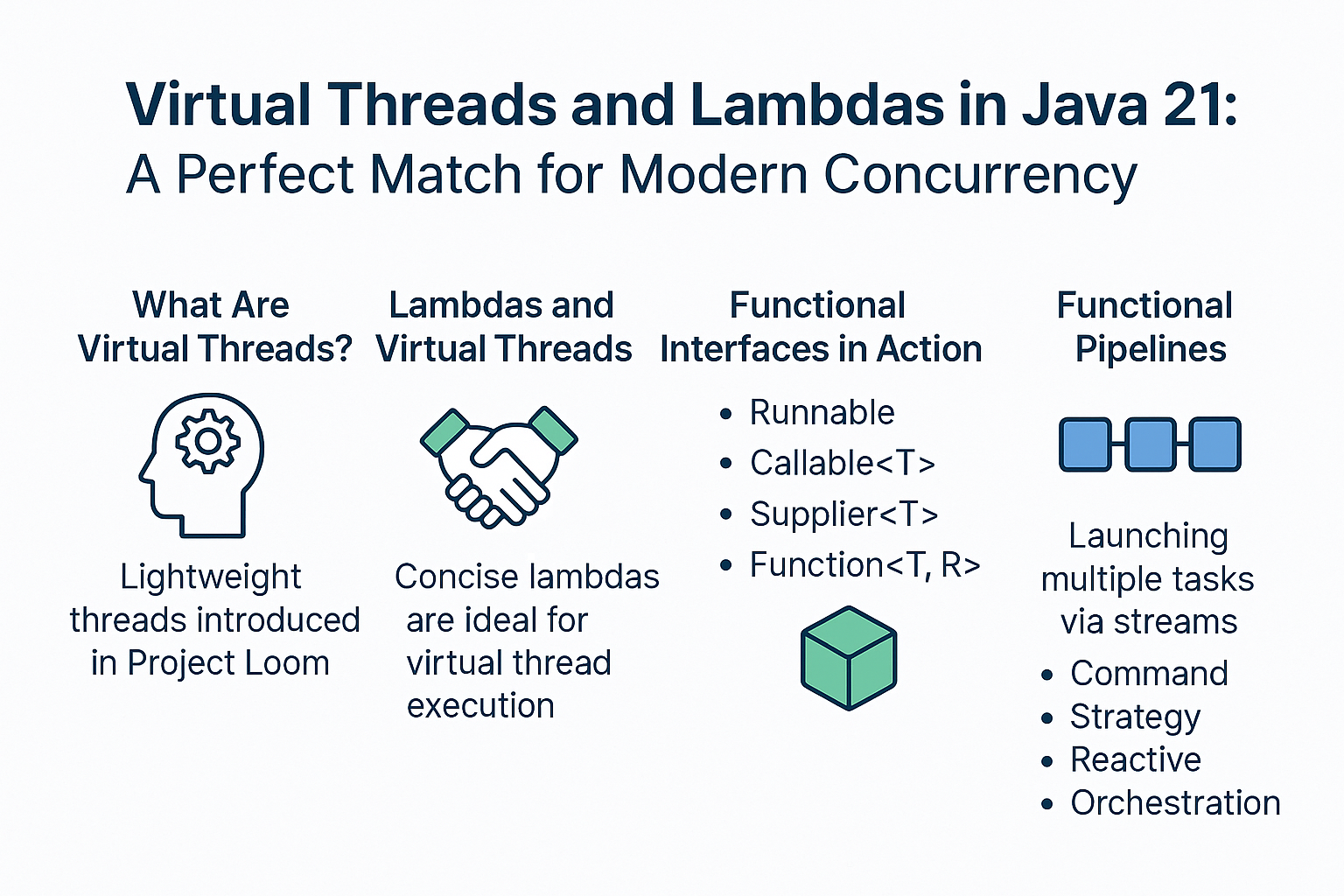With Java 21, virtual threads are now a production-ready feature. These lightweight, schedulable threads pair perfectly with lambda expressions, enabling scalable, maintainable concurrency without sacrificing readability.
In this tutorial, we'll explore why virtual threads and lambdas are a powerful combination, how to use them in real-world projects, and best practices for writing modern concurrent code using functional interfaces.
🧠 What Are Virtual Threads?
Virtual threads are lightweight threads introduced in Project Loom. Unlike platform threads, they don’t rely on a 1:1 mapping with OS threads and are ideal for high-throughput, I/O-bound tasks.
Key benefits:
- Thousands of concurrent tasks
- Low memory footprint
- Simplified concurrency model
- Ideal for request handling, reactive patterns, and task orchestration
🤝 How Lambdas and Virtual Threads Work Together
Java lambdas are concise implementations of functional interfaces like Runnable, Callable, Supplier, and Function. Since these interfaces often represent units of work, they’re the perfect fit for virtual thread execution.
Thread.startVirtualThread(() -> System.out.println("Run in virtual thread!"));
Or with ExecutorService:
ExecutorService executor = Executors.newVirtualThreadPerTaskExecutor();
executor.submit(() -> doTask());
✅ Functional Interfaces in Action
You can use lambdas to define and submit tasks with:
Runnable(no result)Callable<T>(with result)Supplier<T>(deferred computation)Function<T, R>(transformations)
Callable<String> task = () -> "Result from thread";
Future<String> future = executor.submit(task);
🔄 Real-World Use Cases
1. Web Request Handling
Thread.startVirtualThread(() -> {
handleHttpRequest();
});
2. Async File I/O
Runnable readFile = () -> {
try (var reader = new BufferedReader(new FileReader("data.txt"))) {
System.out.println(reader.readLine());
} catch (IOException e) {
e.printStackTrace();
}
};
Thread.startVirtualThread(readFile);
3. REST API Aggregation
ExecutorService exec = Executors.newVirtualThreadPerTaskExecutor();
Callable<String> userCall = () -> fetchUser();
Callable<String> ordersCall = () -> fetchOrders();
Future<String> user = exec.submit(userCall);
Future<String> orders = exec.submit(ordersCall);
String result = user.get() + " & " + orders.get();
⚙️ Functional Pipelines with Virtual Threads
You can use streams to launch multiple tasks:
List<Callable<String>> tasks = List.of(
() -> fetch("A"),
() -> fetch("B"),
() -> fetch("C")
);
ExecutorService exec = Executors.newVirtualThreadPerTaskExecutor();
List<Future<String>> results = tasks.stream()
.map(exec::submit)
.toList();
🧱 Functional Patterns Enhanced by Virtual Threads
- Command pattern: Lambdas as command units executed concurrently
- Strategy pattern: Inject logic into threads using functional interfaces
- Reactive pipelines: Concurrent streams using virtual threads and
Supplier<T> - Orchestration: Submit tasks and compose results via
Function<T, R>
📌 What's New in Java Versions?
Java 8
- Lambdas, Streams, CompletableFuture,
java.util.function
Java 11
varin lambdas, HTTP client API, new string methods
Java 17
- Sealed classes, pattern matching (preview), records
Java 21
- ✅ Virtual Threads (stable)
- ✅ Structured Concurrency (
StructuredTaskScope) - ✅ Scoped Values (for safe context propagation)
- ✅ Full support for lambdas in async, multi-threaded environments
⚠️ Anti-Patterns and Pitfalls
- ❌ Using
Thread.sleep()heavily in virtual threads (they yield but can be abused) - ❌ Mixing virtual threads with shared mutable state
- ❌ Ignoring exception handling in
Future.get() - ❌ Forgetting to close
ExecutorService
🧪 Performance and Thread Safety
- Virtual threads are thread-safe by isolation, not by magic
- Avoid shared mutable state—use
ConcurrentMap, atomic variables, or immutable data - Always shut down executors with
executor.shutdown()
🔄 Refactoring Example
Before: Platform Thread
new Thread(() -> fetchData()).start();
After: Virtual Thread
Thread.startVirtualThread(() -> fetchData());
Before: FixedThreadPool
ExecutorService executor = Executors.newFixedThreadPool(10);
After: Virtual Thread Executor
ExecutorService executor = Executors.newVirtualThreadPerTaskExecutor();
✅ Conclusion and Key Takeaways
- Java 21 virtual threads are lightweight, scalable, and ready for production
- Lambdas fit naturally into virtual thread APIs as
Runnable,Callable, and more - Combine functional programming with async task orchestration for clean, high-performance code
- Always manage lifecycle and exceptions for robust concurrency
❓ FAQ
1. Are virtual threads better than CompletableFuture?
For many I/O-bound tasks, yes—they are simpler and easier to manage.
2. Can I use virtual threads with Spring?
Yes. You can configure Spring to use virtual thread executors for async tasks.
3. What happens when a virtual thread throws an exception?
It behaves like platform threads—uncaught exceptions are handled via Thread.UncaughtExceptionHandler.
4. Are virtual threads safe to use in production?
Yes. Java 21 marks them as stable and production-ready.
5. How many virtual threads can I run?
Thousands to millions—depending on system memory and scheduling overhead.
6. Do lambdas improve performance in virtual threads?
Lambdas improve readability. JVM optimizes them well, especially with virtual threads.
7. Can I debug virtual threads?
Yes—with modern IDEs like IntelliJ or VS Code supporting virtual thread debugging.
8. Do I need to change existing lambdas to use virtual threads?
No. You only need to change how you submit or run them.
9. Can I pass values between virtual threads?
Use ScopedValue or structured scopes for safe context sharing.
10. Is ForkJoinPool obsolete now?
Not obsolete, but many use cases are better served with virtual threads.
